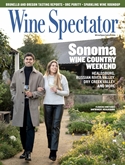Wine tasting is a technique that takes some practice and skill to master. Obviously, wine tasting is the most important activity that goes along with writing a wine review and scoring a wine.
Wine tasting starts with simply looking at the wine. You should look at the wine by pouring it into a clear glass and holding it in front of a white background. This allows you to observe its full color without any background effects. Color differences can be very subtle, and can indicate many aspects of the wine.
Wine tasting starts with simply looking at the wine. You should look at the wine by pouring it into a clear glass and holding it in front of a white background. This allows you to observe its full color without any background effects. Color differences can be very subtle, and can indicate many aspects of the wine.
For example, colors in white wines give different flavors, or might indicate age. You could also tilt the glass to observe the color of the wine's "rim." In wine tasting, a purple color in the rim could indicate a young wine, while brown could mean a mature wine. 
We now know that most of a taste actually comes from our sense of smell. Thus, after observing the wine's color, during a wine tasting you should smell the wine's "bouquet" or "nose." This helps identify subtle tastes that your tongue won't recognize. Then, take a sip of the wine and swish the wine around in your mouth. It was first thought that only certain taste buds on the tongue were able to detect certain tastes like sweetness or bitterness.
We now know this is not true, so swishing the wine in a wine tasting allows all of your taste buds to experience the flavor. While you're tasting it, you should be able to develop a first impression, or what tastes are most apparent from the wine. Next, take a breath with the wine in your mouth to get an idea of the texture of the wine -- light, rich, smooth, or harsh. Last, you can either spit out the wine or swallow it, and get an idea for the wine's aftertaste.

We now know that most of a taste actually comes from our sense of smell. Thus, after observing the wine's color, during a wine tasting you should smell the wine's "bouquet" or "nose." This helps identify subtle tastes that your tongue won't recognize. Then, take a sip of the wine and swish the wine around in your mouth. It was first thought that only certain taste buds on the tongue were able to detect certain tastes like sweetness or bitterness.
We now know this is not true, so swishing the wine in a wine tasting allows all of your taste buds to experience the flavor. While you're tasting it, you should be able to develop a first impression, or what tastes are most apparent from the wine. Next, take a breath with the wine in your mouth to get an idea of the texture of the wine -- light, rich, smooth, or harsh. Last, you can either spit out the wine or swallow it, and get an idea for the wine's aftertaste.

